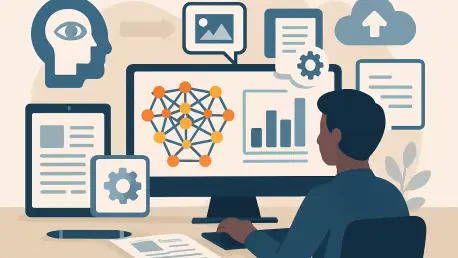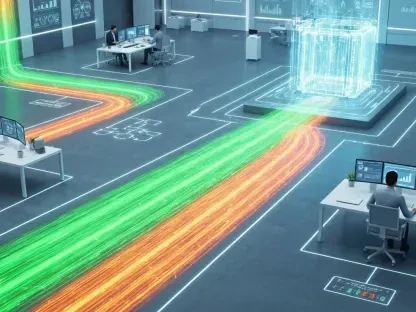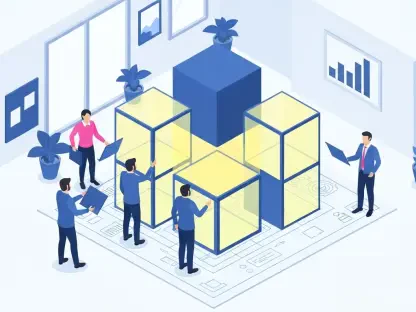Picture a scenario where sprawling stacks of disorganized documents—think handwritten scribbles, worn-out invoices, and intricate legal contracts—are transformed into neatly structured, actionable data in mere moments. This remarkable shift is not a distant fantasy but a tangible reality driven by the emergence of vision-language models (VLMs). These sophisticated artificial intelligence systems merge the capabilities of computer vision with natural language processing to decode both textual content and visual components of documents. Across sectors like finance, healthcare, and law, VLMs are fundamentally changing the landscape of document management by drastically reducing processing times and operational expenses while enhancing precision. The impact of this technology is profound, turning chaotic archives into valuable resources for decision-making. As industries grapple with ever-growing data volumes, exploring how VLMs are driving automation offers critical insights into the future of efficient information handling.
Unleashing Efficiency at Scale
The ability of vision-language models to manage massive document loads with unparalleled speed stands as a cornerstone of their transformative power. Operating within cloud-based infrastructures, these systems can process millions of files simultaneously, slashing latency and cutting down on the hefty costs tied to manual labor. Industries burdened by expanding troves of legacy records, such as financial institutions and medical facilities, find immense value in this capability. What once required extensive human effort over prolonged periods can now be digitized and organized swiftly, enabling faster access to critical information. This efficiency not only streamlines workflows but also allows organizations to redirect resources toward strategic priorities rather than repetitive tasks.
Beyond sheer speed, the scalability of VLMs addresses a pressing need in data-intensive sectors facing exponential growth. The technology’s design to handle vast datasets without compromising performance ensures that even as document volumes swell, processing remains seamless. This is particularly vital for regulatory compliance in finance or patient record management in healthcare, where delays can have significant repercussions. By automating the organization of unstructured data into structured formats, VLMs empower businesses to maintain agility in dynamic environments. The cost savings and time reductions achieved through such scalability mark a pivotal shift, positioning these models as indispensable tools for modern data management challenges.
Redefining Analysis with Multimodal Capabilities
Traditional document processing tools, such as optical character recognition, often falter when faced with non-standard or degraded formats, but vision-language models excel by adopting a comprehensive approach. These systems integrate text and visual analysis to extract meaningful insights from challenging materials, whether it’s deciphering totals on a blurred receipt or understanding annotations on a technical diagram. This ability to replicate human-like reasoning at machine speed sets VLMs apart, making them exceptionally suited for handling diverse documents like legal agreements or clinical reports. The contextual depth they provide elevates raw data extraction into actionable intelligence across multiple industries.
The practical applications of this multimodal strength are vast and impactful, reshaping how complex information is managed. In sectors where precision is non-negotiable, such as regulatory filings in finance or patient histories in healthcare, VLMs deliver results that surpass older methodologies. Their knack for interpreting intricate layouts or handwritten content ensures that no detail is overlooked, even in the most convoluted files. This reliability transforms cumbersome processes into efficient operations, enabling professionals to focus on higher-value tasks rather than manual data sorting. As a result, the adoption of VLMs is rapidly becoming a benchmark for organizations aiming to modernize their document workflows with cutting-edge accuracy.
Democratizing Access and Versatility
One of the most exciting aspects of vision-language models is their increasing accessibility, which allows a wide range of organizations to harness their potential. Through innovations like zero-shot learning, these systems can adapt to unfamiliar document types without the need for extensive retraining, handling everything from historical records to contemporary digital forms with ease. Both open-source platforms and tailored enterprise solutions from leading tech providers are broadening the reach of this technology. This democratization ensures that small businesses and large corporations alike can integrate VLMs into their operations, leveling the playing field in document automation.
Adaptability further enhances the appeal of VLMs, as they can be customized to meet specific industry demands without significant overhead. Whether it’s a legal firm processing contracts or a research institute digitizing archives, the flexibility of these models accommodates diverse needs with minimal setup. This versatility is crucial in a landscape where document formats and requirements vary widely, ensuring that the technology remains relevant across contexts. By lowering barriers to entry and offering scalable solutions, VLMs are paving the way for widespread adoption, enabling entities of all sizes to modernize their data handling practices and stay competitive in an increasingly digital world.
Overcoming Obstacles with Innovative Strategies
While the benefits of vision-language models are undeniable, scaling their deployment presents notable challenges, including high computational requirements and concerns over data security. The intensive resources needed for processing large datasets can strain infrastructure, and safeguarding sensitive information remains a priority in regulated industries. However, emerging techniques like retrieval-augmented generation are proving effective by dynamically accessing relevant contexts, thereby optimizing performance. Such advancements help mitigate the burden on systems while maintaining the high accuracy that VLMs are known for, addressing a critical barrier to broader implementation.
To further enhance reliability, many organizations are exploring hybrid approaches that combine VLMs with rule-based frameworks, especially in high-stakes scenarios like legal documentation or safety protocols. These integrated systems reduce the risk of errors, such as generating inaccurate outputs, by incorporating structured checks alongside AI-driven analysis. This balance ensures that the technology can be trusted in environments where precision is paramount. As solutions to these challenges continue to evolve, the industry is witnessing a maturing ecosystem around VLMs, one that prioritizes both innovation and accountability to maximize their transformative impact on document automation.
Navigating Ethics and Future Possibilities
The automation of intricate document tasks by vision-language models raises important ethical questions, particularly around the potential for job displacement and inherent biases in algorithms. As these systems take on roles traditionally performed by humans, there’s a pressing need to consider their societal implications. A growing consensus among stakeholders advocates for the establishment of ethical guidelines to steer the responsible use of VLMs, ensuring they serve as tools to augment human capabilities rather than replace them. This focus on balance aims to foster trust and maximize the technology’s positive contributions.
Looking to what lies ahead, the trajectory of VLMs appears promising with anticipated developments in areas like prompt engineering and secure on-device processing. These advancements are expected to enhance the models’ efficiency and privacy features, particularly for handling confidential data in sectors like finance or healthcare. The potential for edge computing to bring processing closer to the source also hints at faster, safer automation solutions. As these innovations unfold, they are set to redefine how industries manage information, offering a glimpse into a future where document automation is not just streamlined but also inherently intuitive and protected.









